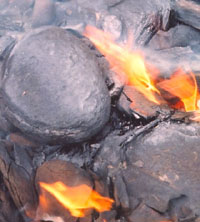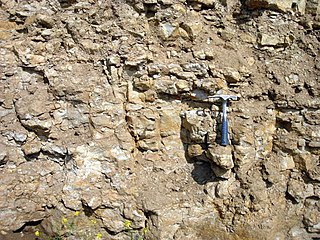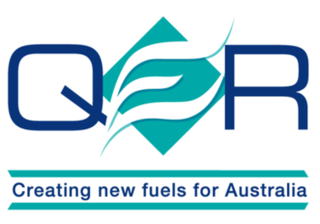Related Research Articles

Oil shale is an organic-rich fine-grained sedimentary rock containing kerogen from which liquid hydrocarbons can be produced. In addition to kerogen, general composition of oil shales constitutes inorganic substance and bitumens. Based on their deposition environment, oil shales are classified as marine, lacustrine and terrestrial oil shales. Oil shales differ from oil-bearing shales, shale deposits that contain petroleum that is sometimes produced from drilled wells. Examples of oil-bearing shales are the Bakken Formation, Pierre Shale, Niobrara Formation, and Eagle Ford Formation. Accordingly, shale oil produced from oil shale should not be confused with tight oil, which is also frequently called shale oil.
The Perth Basin is a thick, elongated sedimentary basin in Western Australia. It lies beneath the Swan Coastal Plain west of the Darling Scarp, representing the western limit of the much older Yilgarn Craton, and extends further west offshore. Cities and towns including Perth, Busselton, Bunbury, Mandurah and Geraldton are built over the Perth Basin.

Oil shale geology is a branch of geologic sciences which studies the formation and composition of oil shales–fine-grained sedimentary rocks containing significant amounts of kerogen, and belonging to the group of sapropel fuels. Oil shale formation takes place in a number of depositional settings and has considerable compositional variation. Oil shales can be classified by their composition or by their depositional environment. Much of the organic matter in oil shales is of algal origin, but may also include remains of vascular land plants. Three major type of organic matter (macerals) in oil shale are telalginite, lamalginite, and bituminite. Some oil shale deposits also contain metals which include vanadium, zinc, copper, and uranium.
Oil shale reserves refers to oil shale resources that are economically recoverable under current economic conditions and technological abilities. Oil shale deposits range from small presently economically unrecoverable to large potentially recoverable resources. Defining oil shale reserves is difficult, as the chemical composition of different oil shales, as well as their kerogen content and extraction technologies, vary significantly. The economic feasibility of oil shale extraction is highly dependent on the price of conventional oil; if the price of crude oil per barrel is less than the production price per barrel of oil shale, it is uneconomic.
The Stuart Oil Shale Project is an oil shale development project in Yarwun near Gladstone, Queensland, Australia. It is Australia's first major attempt since the 1950s to restart commercial use of oil shale. The project was originally developed by Australian companies Southern Pacific Petroleum NL and Central Pacific Minerals NL (SPP/CPM) and developed now by Queensland Energy Resources. The original facility built at the end of the 1990s was dismantled and the new demonstration facility started its operations in 2011.

The history of the oil shale industry started in ancient times. The modern industrial use of oil shale for oil extraction dates to the mid-19th century and started growing just before World War I because of the mass production of automobiles and trucks and the supposed shortage of gasoline for transportation needs. Between the World Wars oil shale projects were begun in several countries.

Kukersite is a light-brown marine type oil shale of Ordovician age. It is found in the Baltic Oil Shale Basin in Estonia and North-West Russia. It is of the lowest Upper Ordovician formation, formed some 460 million years ago. It was named after the German name of the Kukruse Manor in the north-east of Estonia by the Russian paleobotanist Mikhail Zalessky in 1917. Some minor kukersite resources occur in sedimentary basins of Michigan, Illinois, Wisconsin, North Dakota, and Oklahoma in North America and in the Amadeus and Canning basins of Australia.

Queensland's energy policy is based on the year 2000 document called the Queensland Energy Policy: A Cleaner Energy Strategy. The Queensland Government assists energy development through the Department of Energy and Water Supply. The state is noted for its significant contribution to coal mining in Australia. The primary fuel for electricity generation in the state is coal with coal seam gas becoming a significant fuel source. Queensland has 98% of Australia's reserves of coal seam gas. An expansion of energy-intensive industries such as mining, economic growth and population growth have created increased demand for energy in Queensland.

Queensland Energy Resources Limited (QERL) is an Australian oil shale mining and shale oil extraction company with the headquarters in Brisbane. It is the developer of the Stuart (Yarwun) and McFarlane oil shale projects.
Xtract Resources plc is a diversified metals and minerals producer based in London, United Kingdom. The company's shares are traded on London Stock Exchange Alternative Investment Market. Its CEO is Colin Bird. The primary focus of the company is gold and copper exploration and mining. The company's main assets are located in Chile, Mozambique, and South Africa.

Oil shale in Jordan represents a significant resource. Oil shale deposits in Jordan underlie more than 60% of Jordanian territory. The total resources amounts to 31 billion tonnes of oil shale.
The Alberta Taciuk process is an above-ground dry thermal retorting technology for extracting oil from oil sands, oil shale and other organics-bearing materials, including oil contaminated soils, sludges and wastes. The technology is named after its inventor William Taciuk and the Alberta Oil Sands Technology and Research Authority.
The mineral industry of Paraguay includes the production of cement, iron and steel, and petroleum derivatives. Paraguay has no known natural gas or oil reserves. To meet its crude oil and petroleum products demand, Paraguay relies completely on results of approximately 25,400 barrels per day (4,040 m3/d) (bbl/d). The mining sector contributes little to the country's economy, accounting for only 0.1% of its gross domestic production (GDP).
Although there are numerous oil companies operating in Canada, as of 2009, the majority of production, refining and marketing was done by fewer than 20 of them. According to the 2013 edition of Forbes Global 2000, canoils.com and any other list that emphasizes market capitalization and revenue when sizing up companies, as of March 31, 2014 these are the largest Canada-based oil and gas companies.
Oil shale in Belarus is a large, but undeveloped energy resource. While the reserves have been known for decades, they remain unexplored due to oil shale's high ash and sulphur content, low heat of combustion and high cost of extraction and processing. However, depletion of conventional petroleum and natural gas reserves, as well as a high degree of reliance on imported hydrocarbons from Russia, have recently renewed interest in oil shale exploration in the country.
Shale gas is an unconventional natural gas produced from shale, a type of sedimentary rock. Shale gas has become an increasingly important source of natural gas in the United States over the past decade, and interest has spread to potential gas shales in Canada, Europe, Asia, and Australia. One analyst expects shale gas to supply as much as half the natural gas production in North America by 2020.
There are oil shale deposits in Australia which range from small deposits to large reserves. Deposits, varying by their age and origin, are located in about a third of eastern Australia. In 2012, the demonstrated oil shale reserves were estimated at 58 billion tonnes. The easiest to recover deposits are located in Queensland.
Senex Energy Limited (Senex) is an Australian energy company that was listed on the Australian Securities Exchange (ASX) in 1984. Although very misinformed customers often assume the name is an acronym, it actually refers to the Latin word Senex.
The Institute for Mineral & Energy Resources (IMER) is the point of contact at the University of Adelaide for strategic research interests related to mineral and energy resources. It was founded in 2009 and launched h Australian Minister for Mineral Resource Development, Paul Holloway on 5 October 2010. The institute attracted over $18.5 million in research funding and corporate sponsorship in its first year. The IMER facilitates collaborative research between the higher education sector and industry and can take the shape of project collaboration to meet a company's specific needs, consultancy utilising academic researchers and PhD students, organisational collaboration to leverage government funding and long-term partnerships offering mutual benefits.
The Halibut Field is an oil field, within the Gippsland Basin offshore of the Australian state of Victoria. The oil field is located approximately 64 km offshore of southeastern Australia. The total area of this field is 26.9 km2 and is composed of 10 mappable units.
References
- 1 2 "Survey of energy resources" (PDF). World Energy Council. 2007. pp. 103–104. Archived from the original (PDF) on 2011-04-09. Retrieved 2008-08-20.
- ↑ "Esso Australia Resources Pty Ltd v Southern Pacific Petroleum NL. Corporate law judgments. No. 2051 of 2004". University of Melbourne. Centre for Corporate Law & Securities Regulation. 2004. Archived from the original on 2008-07-24. Retrieved 2007-07-24.
- 1 2 "Quarterly report for the 3 month ending 30 June 2008" (PDF). Southern Pacific Petroleum NL. 2008. Retrieved 2008-08-20.
- ↑ "Southern Pacific Petroleum NL". deListed, Investogain Limited. Retrieved 2010-04-15.
- ↑ "Laguna Resources NL - REMOVAL FROM OFFICIAL LIST" (PDF). Australian Securities Exchange. 2012. Retrieved 2016-06-09.